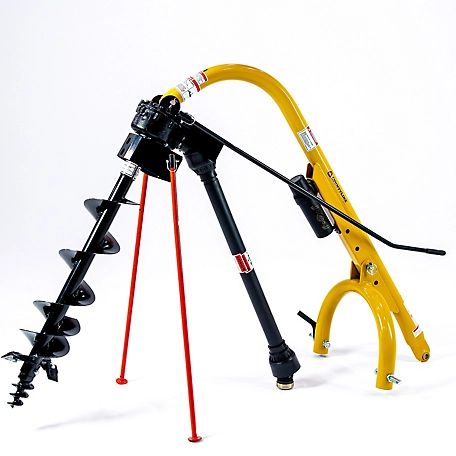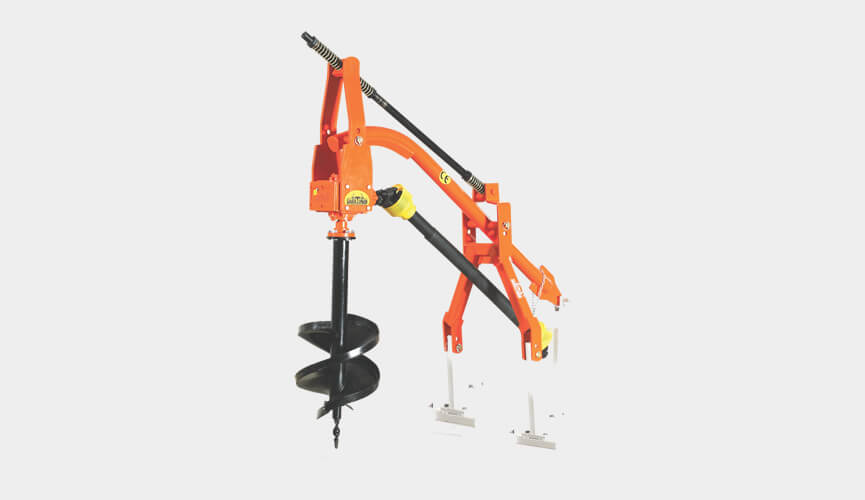Product Description
Product Description
Product Parameters
|
Model |
Unit |
HMB 2500 |
HMB 3000 |
HMB 3500 |
HMB 4000 |
HMB 6000 |
HMB 8000 |
HMB 9000 |
|
Excavator Weight |
Ton |
1.2-2.5 |
2-3 |
2-3.5 |
2.5-4.5 |
4.5-6.0 |
6.0-8.0 |
7.0-10.0 |
|
Pressure |
Bar |
310 |
310 |
260 |
260 |
310 |
310 |
310 |
|
Working Flow Rate |
L/min |
25-50 |
25-50 |
30-60 |
35-65 |
40-70 |
40-70 |
50-90 |
|
Max Operating |
Nm |
1962 |
2470 |
2933 |
3800 |
5561 |
7915 |
9015 |
|
Output Shaft |
mm |
65 S4 |
65 S4 |
65 S4 |
65 S4 |
75 S5 |
75 S5 |
75 S5 |
|
Unit Weight |
kg |
54 |
54 |
71 |
71 |
71 |
90 |
92 |
|
Unit Height |
mm |
595 |
595 |
700 |
700 |
700 |
700 |
700 |
|
Unit Diameter |
mm |
200 |
200 |
238 |
238 |
238 |
270 |
270 |
|
Standard Auger |
mm |
1.2 |
1.2 |
1.2 |
1.2 |
1.2 |
1.5 |
1.5 |
|
Auger Diamater Range |
mm |
100-400 |
100-500 |
100-600 |
100-750 |
100-900 |
150-750 |
450-900 |
|
A complete auger drill includes a power head, a double pin hitch and a drill, so please see the prices seperately. |
||||||||
How to choose the correct model?
1. Knowing the model and applicable weight of the excavator.
2. Knowing the diameter and depth of the hole to be drilled.
3. Knowing the working environment and the soil condition.
4. The desired speed and other requirements.
Packing & Delivery
PACKING DETAILS
1. Inner is stretch film, outside is export wooden case or as customer’s request.
2.The standard free spare parts: 2 hoses, a set of repair tools with tool box.
Company Profile
Located in HangZhou, ZheJiang province, established in 2009, HangZhou CHINAMFG Construction Machinery Equipment Co.,Ltd registered HMB Brand in 2011. We started to develop oversea market in 2013.With 8 years experience, specialized in manufacturing Hydraulic Breakers, Quick Couplers, Excavator Palte Compactors, Earth Augers and Spare Parts. Our own brand “HMB” hydraulic breakers have full series and are compatible to all brands’ excavators.
Exhibition Show
FAQ
Q: Are you a manufacturer?
A: Yes,our factory was established in 2009 and we have our own foreigh trade department.
Q: Are you sure your product will fit my excavator?
A: Yes, we are professional about this, you can also tell me your excavator model, and we will recommend you the right model.
Q: Can you provide customers’ design?
A: Sure, we can provide OEM and ODM service.
Q: What’s the MOQ and payment terms?
A: MOQ is 1set. Payment via T/T,L/C, Western Union accepted, other terms can be negotiated.
Q: How about delivery time?
A: 5-25 work days after the payment, depend on your quantity.
Q: How about the package?
A: Our earth auger packed by polywood case.
Q: Which country have you exported?
A:Our products have been exported to 63 countries and regions in the world, such as United States, Ireland, Sweden, France, Norway and so on.
/* March 10, 2571 17:59:20 */!function(){function s(e,r){var a,o={};try{e&&e.split(“,”).forEach(function(e,t){e&&(a=e.match(/(.*?):(.*)$/))&&1
| After-sales Service: | One Line Service and Local Service |
|---|---|
| Warranty: | 1 Year |
| Certification: | CE |
| Condition: | New |
| Drill Hole Diameter: | 100-150mm |
| Drill Hole Depth: | 10-30m |
| Customization: |
Available
| Customized Request |
|---|

What factors should be considered when selecting the right post hole digger for a job?
When choosing the appropriate post hole digger for a job, several factors should be taken into consideration. These factors help ensure that the selected digger is well-suited for the specific requirements of the project. Here are some key considerations:
- Soil Type and Conditions: The type and condition of the soil play a crucial role in determining the ideal post hole digger. Consider whether the soil is soft, sandy, clayey, compacted, or rocky. Different diggers have varying capabilities in handling these soil types. For example, harder soils may require more powerful motorized diggers or specialized blades, while softer soils may be manageable with manual or smaller-sized diggers.
- Project Scale and Scope: The scale and scope of the project influence the selection of a post hole digger. Determine the number of holes that need to be dug and the depth and diameter requirements of the holes. Larger projects with numerous holes may benefit from motorized diggers that offer faster and more efficient digging. Smaller projects or occasional use may warrant manual diggers for cost-effectiveness.
- Available Power Source: Consider the availability of power sources at the job site. Motorized post hole diggers typically require access to electricity or fuel, such as gas or propane. If the job site lacks these power sources, manual diggers may be a more suitable choice. Additionally, consider the portability and maneuverability of the digger if the job site is in a remote or hard-to-reach location.
- Operator Experience and Strength: Assess the experience and physical strength of the operator(s) who will be using the post hole digger. Motorized diggers are generally more powerful and require less physical effort compared to manual diggers. If the operator is inexperienced or lacks sufficient strength, it may be advisable to opt for a motorized digger to ensure efficient and safe operation.
- Budget and Cost Considerations: Set a budget for the post hole digging project and consider the cost of different digger options. Motorized diggers tend to be more expensive upfront but can save time and effort in the long run, especially for larger projects. Manual diggers are typically more budget-friendly but may require more physical exertion and time investment.
- Additional Features and Accessories: Evaluate any additional features or accessories that may be beneficial for the project. Some post hole diggers offer adjustable depth settings, ergonomic handles, or anti-vibration systems for operator comfort. Assess whether any specific accessories, such as auger extensions or sharpening tools, are available or needed for the task at hand.
By considering these factors, project managers or individuals can make an informed decision when selecting the right post hole digger. It is essential to choose a digger that matches the soil conditions, project requirements, available power sources, operator capabilities, budget, and any desired additional features or accessories.

How do post hole diggers handle variations in hole diameter and depth?
Post hole diggers are designed to handle variations in both hole diameter and depth, providing flexibility and adaptability for different project requirements. Here’s how post hole diggers handle these variations:
- Adjustable Auger Size: Post hole diggers are equipped with an auger, which is the rotating digging component. Many post hole diggers feature interchangeable auger bits of different sizes. These auger bits come in various diameters, allowing users to select the appropriate size for the desired hole diameter. By swapping out the auger bits, post hole diggers can easily handle variations in hole diameter to accommodate different project needs.
- Telescoping or Extension Shafts: Some post hole diggers come with telescoping or extension shafts. These shafts can be adjusted in length to extend the reach of the digger, enabling users to dig holes at different depths. By extending or retracting the shaft, post hole diggers can handle variations in hole depth, allowing for deeper or shallower holes as required by the specific project.
- Adjustable Depth Control Mechanisms: Many post hole diggers incorporate adjustable depth control mechanisms. These mechanisms allow users to set the desired depth of the hole before starting the digging process. By utilizing depth control features such as depth collars or depth stoppers, operators can ensure consistent and accurate hole depths throughout the project, even when dealing with variations in terrain or soil conditions.
- Graduated Markings or Measurements: Some post hole diggers have graduated markings or measurements on the shaft or handle. These markings provide a visual reference for the operator to gauge the depth of the hole while digging. By referring to the measurements, users can monitor and adjust the depth as needed, ensuring precise control over variations in hole depth.
- Manual or Powered Operation: Post hole diggers are available in both manual and powered versions. Manual post hole diggers require the operator to exert physical force to dig the hole, offering fine control over the digging process. Powered post hole diggers, such as those driven by gas engines or electric motors, provide additional power and speed, making it easier to handle variations in hole diameter and depth more efficiently.
- Operator Technique: The operator’s technique also plays a role in handling variations in hole diameter and depth. Experienced operators can skillfully manipulate the post hole digger to achieve the desired dimensions. By controlling the angle, position, and movement of the digger, operators can adapt to variations in the terrain, soil conditions, and project requirements, effectively managing changes in hole diameter and depth.
By incorporating features such as adjustable auger size, telescoping or extension shafts, adjustable depth control mechanisms, graduated markings or measurements, and offering both manual and powered options, post hole diggers provide the means to handle variations in hole diameter and depth. Additionally, the operator’s technique and skill contribute to achieving precise and consistent results, ensuring that the post hole digger can effectively adapt to the specific requirements of different projects.

What is a post hole digger and how does it work?
A post hole digger is a tool used to manually or mechanically dig holes in the ground for various purposes, such as installing fence posts, signposts, or planting trees. It consists of a long shaft with handles at the top and a digging mechanism at the bottom.
The digging mechanism of a post hole digger typically consists of two sharp metal blades or scoops, known as augers, attached to the bottom of the shaft. The augers are shaped like spirals to help drive them into the ground and remove soil from the hole.
When using a manual post hole digger, the operator positions the blades at the desired location and pushes the handles downward. The downward force combined with a twisting motion allows the augers to penetrate the soil. The operator then lifts the digger out of the hole, bringing the loosened soil to the surface. The process is repeated until the desired depth is reached.
For larger or more challenging digging tasks, there are also mechanical post hole diggers available. These tools are often powered by gas engines or electric motors. Mechanized post hole diggers operate similarly to manual ones, but the power source provides the necessary force to drive the augers into the ground more easily and quickly.
Post hole diggers come in various sizes to accommodate different hole diameters and depths. The size of the augers determines the width of the hole, while the length of the shaft determines the depth that can be achieved.
In summary, a post hole digger is a tool used for digging holes in the ground. It works by using sharp augers to penetrate and remove soil, either through manual force or with the assistance of a power source in the case of mechanical diggers.


editor by CX 2023-12-31